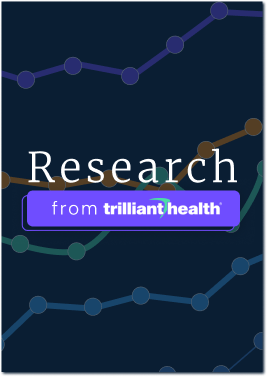Counterpoint
Hal Andrews | March 18, 2025No Good Deed Goes Unpunished, Healthcare Edition: Price Controls for Hospitals, the Only Health Economy Stakeholder With Unlimited Downside Risk – Part 1
I wrote recently about two proposed bills in the Indiana House of Representatives that would establish price controls on not-for-profit hospitals in the state and remove tax-exempt status from systems that failed to comply. These bills incorporate a policy endorsed by the Congressional Budget Office (CBO) in 2022, which concluded this:

I have spent most of the last 35 years in the hospital business: acquiring or selling hospitals or developing joint ventures with hospitals or providing clinical or financial technology to hospitals or delivering strategic analytics to hospitals. As we say in the South, hospital executives are “my people.” And, as we do in the South, I can criticize “my people” but will also defend them against their enemies.
It is hard to imagine that any health economy stakeholder has more enemies than hospitals at this moment. It is equally hard to understand how that has happened, calling into question the effectiveness of almost every national and state hospital association. Apart from physicians and nurses, there is no more important stakeholder in the health economy than hospitals, which makes it easy for me to defend them against an onslaught of irrational, illogical, ill-informed and increasingly malicious market forces.
Because hospital executives are “my people,” I can and frequently do note the flaws that are common to many hospitals, including poor governance, “directionally correct” strategic planning, suboptimal resource allocation, inconsistent quality, inscrutable billing processes and, most notably, a fervent commitment to the status quo. Of course, I could level most of those criticisms, and others, at health plans and life sciences companies.
Even so, every American can, and implicitly does, rely uniquely on hospitals as the provider of last resort, if only because of Federal mandate. Since 1986, the Emergency Medical Treatment and Active Labor Act (EMTALA) requires “hospitals with emergency departments to provide a medical screening examination to any individual who comes to the emergency department and requests such an examination, and prohibits hospitals with emergency departments from refusing to examine or treat individuals with an emergency medical condition” and any such “medical screening examination and/or stabilizing treatment is not to be delayed in order to inquire about payment status.”1
Consequently, EMTALA statutorily requires hospitals to be prepared to accept unlimited financial risk for the next patient through the door, 24 hours per day, seven days per week. No other health economy stakeholder, whether a physician or clinic or health insurer or life sciences company or supplier, is required to take that financial risk on any patient. In contrast, health insurers, to the extent they even have financial risk, think of nothing other than reducing their risk on every member.
Federal government reimburses hospitals for treating Medicare beneficiaries in an amount that is, on average, below the cost of care. According to the Medicare Payment Advisory Commission (MedPAC), average Medicare margins range from 0.1% for for-profit hospitals to -14.3% for not-for-profit hospitals.2 State governments directly or indirectly reimburse hospitals for treating Medicaid enrollees in an amount ranging from 37% to 111% of Medicare rates, but less than 100% of Medicare rates in 45 states.3 According to this report from EY, the aggregate shortfall from Medicare and Medicaid reimbursement for Indiana not-for-profit hospitals exceeded $2.8B in 2022.
Experts in the hospital industry – which are a dwindling herd – know that the emergency department is the hospital’s “front door.” For a typical hospital, ~50% of inpatient admissions originate in the emergency department. Nationally, the payer mix in emergency departments is 35% Medicaid, 26% Medicare/Medicare Advantage and 39% commercial insurance.4 When accounting for the uninsured population, at least 65% of emergency department visits are reimbursed below the cost of care, if at all.
So, Federal and state government knowingly reimburses hospitals at rates that are below the cost of care while simultaneously mandating that hospitals take unlimited, and therefore unknowable, financial risk on a significant portion of their patients. It beggars belief that these same people now want to impose price controls on hospitals throughout America.
EMTALA would be the healthcare version of “losing money on every sale but making up for it with volume” but for one thing: employer-sponsored health insurance. As I have said on many occasions, employers are the parasitic host of the entire health economy.
Thanks to RAND, everybody knows that commercial insurance reimbursement rates are ~250% of Medicare rates, even if almost no one understands the flaws of that oft-cited study, which is the starting point for proposed legislation on hospital pricing in several states. Although actual – not relative – rates are publicly available under CMS’s Transparency in Coverage regulation, RAND decreed that
“these data have not been useful, largely because of their size and complexity and because they lack context on service quantities and include data for providers that do not perform services.”5
In the hospital industry, it is axiomatic that a nurse can break an anvil. In public policy, it is axiomatic that bad facts make bad law. It is, perhaps, notable that a research organization with almost $500M of revenue is incapable of addressing the “size and complexity” of the health plan price transparency data. Likewise, it is, perhaps, unwise to base public policy on a sample that “represents approximately 6 percent of U.S. commercial insurance hospital spending” when a preponderance of actual data is readily available.6
As I have written previously, it is unsurprising that three Ivy League PhD economists in the CBO – but with no meaningful “real world” experience - concluded that price controls were the most effective approach to control prices. And, having commented on the drafts of the CBO paper, it is, perhaps, unsurprising that Christopher Whaley co-authored the RAND report.
Setting aside the question of whether a handful of Beltway economists are well-suited to prescribe policies that impact every American, there are several unasked questions that deserve an answer. First, and most importantly, why has society allowed Federal and state government to underpay hospitals for decades while forcing them to accept unlimited financial risk under EMTALA? Second, and relatedly, why have employers knowingly cross-subsidized inadequate government reimbursement for healthcare services for decades? Third, why are employers so slow to exercise their fiduciary duties to use publicly available information to make informed decisions about healthcare benefits for their employees? Fourth, how is it that public officials and employers are seemingly oblivious to the downstream impact of price controls on hospitals?
Legislators around the country seem to have forgotten the fact that bad facts make bad law, whether because of poor memory or the undue influence of lobbyists and policy zealots who have never worked a day in an emergency department. Ironically, one surprisingly influential stakeholder in the assault on hospitals became a billionaire by trading energy futures, a rather risky business. I would risk a large sum to bet that he did not earn billions by executing trades in which his upside was capped and his downside was uncapped.
Only five years ago, the world celebrated the bravery and endurance of hospitals, physicians, nurses and other clinical and support personnel during the COVID-19 pandemic. In many cities around the world, hospitals were not only the provider of last resort but the sole provider of care. How quickly the world has forgotten.
Implementing price controls on hospitals is an easy legislative approach, which makes it optimal for ill-informed politicians. Additionally, price controls are not a free market approach, which makes it attractive to power-hungry politicians, which I know is a tautology.
More importantly, implementing price controls will have unintended consequences, one of which is certain – accelerating the closure of more hospitals, many of which are teetering on the edge of insolvency. Having spent countless hours in communities whose hospitals closed, I know that access to healthcare doesn’t improve when a hospital closes. I also know that most voters in those communities never forget the day the hospital closed, and they exact their revenge in the voting booth. Similarly, employers supporting price controls, whether tacitly or explicitly, can be certain that their employees who are upset by a $10 increase in their co-pay will be incensed when they lose access to care.
The principles of economics suggest it would be naïve to think that price controls on hospitals will not also impact physicians and nurses, particularly in states in which the majority of physicians are employed. While there are no published reports of a shortage of highly paid executives of health plans, life sciences companies, benefits consultants and insurance brokers, America’s need for more physicians and nurses is well-documented. The COVID-19 pandemic demonstrated that Americans are willing to pick up and move in response to government overreach, and there is no shortage of hospitals in Sunbelt states with low taxes that need more physicians and nurses.
There is a market-based solution to America’s healthcare cost crisis: value for money, which I have written about extensively:
- The Case for the First Principles of Value For Money
- Employers Care About Value for Money, Not Value-Based Care
- Field Guide: A Primer on Value for Money
- How Congressional Tyranny Constrains Value for Money in the Health Economy
- How Elon Musk Might Transform the U.S. Healthcare System
- It's All About the Rate
- Can You Defend Your Rate?
- If Health Economy Stakeholders Really Care About Quality, It Sure Is Hard To Tell
- Innovation, Transformation and Other Healthcare Fairy Tales
- The Mythical Pricing Power of Monopoly Health Systems
- How Health Plan Price Transparency Indicts Stakeholders Throughout the Health Economy
- 7 Strategic Healthcare Implications of the 2024 Presidential Election
- A Practical Approach to Health Equity, Part 1
- Why the Mark Cuban Cost Plus Drug Company Is a Boon for the Pharmaceutical Industry
- A Potential Reckoning for Health Economy Stakeholders Through the Lens of Oscar-Winning Movies, First Principles and Black Swan Events
- National Health Expenditures: Down the Rabbit Hole and Through the Looking Glass
- 2024 Trends Shaping the Health Economy Report
Price transparency, the most notable healthcare policy of the current White House administration, makes value for money a viable, and much more American, alternative to solve healthcare’s cost crisis. Before opening Pandora’s box with price controls, state legislators and policymakers might want to consider what they might unknowingly and unintentionally unleash.
Footnotes:
1. CMS, Certification and Compliance For The Emergency Medical Treatment and Labor Act (EMTALA)
3. KFF, Medicaid-to-Medicare Fee Index, 2019
4. Trilliant Health's National All-Payer Claims Dataset
5. RAND, Prices Paid to Hospitals by Private Health Plans, page 2
6. RAND, Prices Paid to Hospitals by Private Health Plans, page vi






















.png)

















.png?width=171&height=239&name=2025%20Trends%20Report%20Nav%20(1).png)
